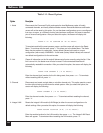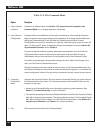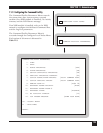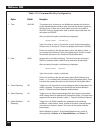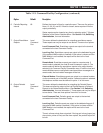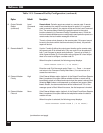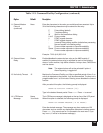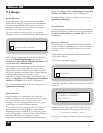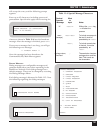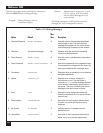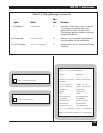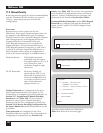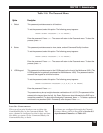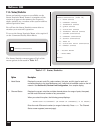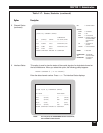
Multiserver 5000
140
11.4 Messages
ALARM MESSAGES
Alarms generally indicate that an error has been
detected that impacts or degrades the performance
for part of the network. For example, an alarm
message would be sent if the line error rates were
excessive, or if a link went down.
To clear an alarm, select option 9 (Clear Alarm
Displays) from the Command Facility Main Menu or
select Clear Latched Alarms on the LCD/Keypad.
(See the LCD Blinking Backlight discussion in
Section 13.1, General LCD/Keypad Information. See
also Section 13.5, Administration.)
The output of alarm messages can be selected via
the Output Event/Alarm Reports menu. Alarm
Reporting must be enabled or you will not receive
any alarm messages. (Output Event/Alarm Reports
and Alarm Reporting are options 7 and 4,
respectively, of the Command Facility Parameters
Menu. See Section 11.3, Configuring the Command
Facility, and Table 11-3 for more information.)
For a list and description of all the alarms, refer to
Appendix D, Messages.
E
VENT MESSAGES
Event messages are reported in real time and
indicate changes in the network that do not impact
the overall performance of the network. For
example, an event message will be sent if a port is
connecting or a local link has restarted.
The output of event messages can be selected via
the Output Event/Alarm Reports menu. Event
Reporting must be enabled or you will not receive
any event messages. (Output Event/Alarm Reports
and Event Reporting are options 7 and 3,
respectively, of the Command Facility Parameters
Menu. See Section 11.3, Configuring the Command
Facility, and Table 11-3 for more information.)
For a list and description of all the events, refer to
Appendix C, Messages.
C
LASS MESSAGES
A class message is what appears on the screen when
the user successfully connects to the requested class.
See Section 10.8, Classes, and Table 10-3 for more
information.
B
ROADCAST MESSAGES
Broadcasting is an administration function which
allows the system administrator to send a message to
an async port or to a group of async ports on the
network.
To broadcast, select option 6 from the Command
Facility Main Menu.
The following prompt appears:
Enter the node ID and channel number or range of
channels.
If there is a non-async port in the range selected,
the following message will appear on the screen:
** INCORRECT CHANNEL TYPE **
If the port or range selected is all async, the system
COMMAND FACILITY MAIN MENU [node id]
CLEAR ALARM DISPLAYS
9
COMMAND FACILITY MAIN MENU [node id]
BROADCAST
6
ENTER NODE-ID/CHANNEL#
(OR RANGE OF CHANNELS)
(^X TO ABORT):



